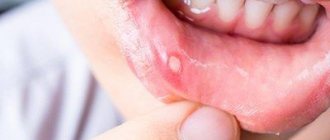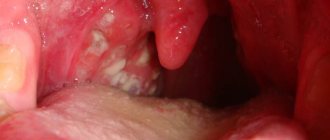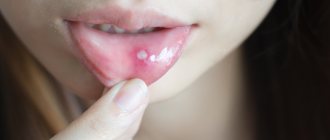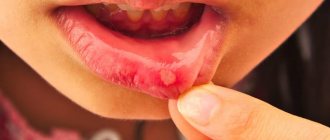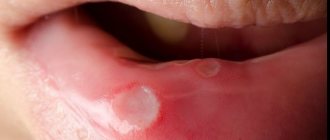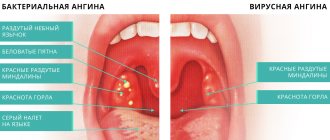Stomatitis is an inflammatory process of the oral mucosa, often of infectious or allergic origin. Stomatitis is one of the most common oral diseases in children of all ages, from infants to school-age children, although it can sometimes occur in adults. The special predisposition of children to this disease is explained by the fact that at a young age the mucous membrane of the oral cavity is more tender and thinner than in adults.
Types of stomatitis and causes of occurrence in children
The causes of stomatitis in children can be different, and they are directly related to the type of disease. In this section, we will look at the main types of stomatitis and their causes in children.
Herpetic viral stomatitis
This type of stomatitis is the most common and common. Sometimes this type of disease is simply called herpetic stomatitis or viral . Typically occurs in children aged 1 to 4 years.
Often infection occurs through airborne droplets. Infection with herpetic viral stomatitis is also possible through children's toys, dishes and other objects. Against the background of weak immunity, the virus enters the body and settles in the most damaged areas of the mucous membrane. Such places can serve, for example, as small wounds that appear after a child bites his lips.
Aphthous (allergic) stomatitis
This type of stomatitis is often also called drug stomatitis , since the main reason for the appearance of this type of disease is allergic reactions to various medications. It is impossible to say exactly which drugs can cause stomatitis; this is an individual predisposition, and can only be accurately determined by visiting a pediatric dentist after all the necessary diagnostics have been carried out. This type of disease occurs infrequently and, most often, in preschool children.
Traumatic stomatitis
As the name implies, this type of disease occurs after mechanical trauma to the child’s oral cavity and the entry of dirt and bacteria into these places.
Injuries can be of a completely different nature. This could be purely a dental problem. For example, due to an incorrect bite, a child may constantly bite his tongue or lips. Other types of mechanical damage to the mucous membrane include burns, for example, from food that is too hot, a pacifier that is too hard, various bad habits (pulling toys into the mouth, chewing a pencil, etc.).
Candidal (fungal) stomatitis
The main cause of candidal stomatitis is Candida fungi. Basically, this type of disease is typical for children under 1 year of age who are breastfed. Particles of mother's milk remaining in the baby's mouth after feeding provide an excellent environment for the development of this type of fungus. For this reason, sometimes this type of stomatitis is called thrush .
Infectious (microbial) stomatitis
The main reason for the appearance of infectious stomatitis in children is a decrease in immunity against the background of diseases such as tonsillitis, sinusitis, pneumonia and other diseases of the nasopharynx. This type of disease occurs in children of both school and preschool age. Infectious stomatitis develops especially often in the autumn-winter period, when the child’s immunity is weakened.
Symptoms
The disease has rather sparse symptoms. Visually, it is easy to identify by the presence of characteristic ulcers on the inside of the lips, cheeks, soft palate and tongue (rarely). Keratinized (fixed) gums are not affected by aphthous stomatitis, which is another difference between aphthous stomatitis and herpetic stomatitis. At the initial stage of aphthae, the patient usually feels discomfort and burning, and the temperature may rise slightly. Diagnosis involves a visual examination, as well as taking blood tests and mucosal smears if the doctor suspects the presence of concomitant diseases.
Symptoms of stomatitis in children
Just like the causes of stomatitis in children, its symptoms are broad and also depend on the type of disease. In this section we will group the characteristic symptoms for each form of stomatitis in children.
Symptoms of viral stomatitis in children
The main symptom of viral (herpetic) stomatitis is the appearance of bubbles on the oral mucosa, which, after opening, form small erosions covered with plaque. Such erosions can be multiple in nature and located either at a distance from each other or merge together, forming large affected areas of the oral mucosa. They can be located on the lips, larynx, cheeks, tongue or roof of the mouth and are usually very painful and react strongly to touch, hot or cold food and other stimuli.
Symptoms of candidal stomatitis in children
Usually, before the onset of candidal stomatitis, the child experiences dryness of the oral mucosa, a burning sensation, an unpleasant taste and bad breath. Based on the baby's behavior, one can suspect the onset of the disease. As a rule, during this period, children are capricious while eating, behave restlessly, and sleep poorly. Further, as the disease develops, many small white dots appear, which form the affected area, covered with a white cheesy coating. In advanced forms of the disease, the plaque may turn gray. This indicates the transition of the disease to a severe form. In severe forms of candidal stomatitis, it is difficult to cleanse the mucous membrane of plaque and, at the slightest touch to the damaged area, it results in severe pain and bleeding.
Symptoms of bacterial (infectious) stomatitis in children
- The mucous membrane turns dark red; - The formation of yellow crusts occurs, which seem to stick together the lips; — The child experiences increased salivation; - Bad breath appears.
Also, depending on the infection that caused stomatitis, the following symptoms may be observed: the formation of fibrinous films, bleeding of damaged areas, severe plaque on the tongue.
Symptoms of aphthous stomatitis in children
With aphthous stomatitis, ulcers and aphthae form on the oral mucosa. Aphtha is a painful, round-shaped area of mucous membrane covered with fibrinous plaque. With aphthous stomatitis, children become lethargic, irritable, moody and complain of pain in the oral cavity. As a rule, aphthous stomatitis is chronic and can worsen 1–2 times a year.
Causes
To date, the exact etiology of aphthous stomatitis has not been fully identified. The main cause is considered to be a disruption of the immune system (uncontrolled activation of lymphocytes and neutrophils, which begin to destroy epithelial cells). At some point, the immune system ceases to recognize a number of components contained in saliva, which provokes the appearance of characteristic ulcers. However, this is far from the only reason. The aphthous form of stomatitis occurs under the influence of other factors:
- genetic predisposition
- immune system diseases
- gastrointestinal diseases
- neutropenia, Behcet's syndrome
- allergies to sodium lauryl sulfate, citrus fruits, dairy products, grains
- viruses and pathogenic bacteria (staphylococci)
- mucosal injuries
- avitaminosis
- pregnancy
- psychological disorders
Treatment of stomatitis in children
There is no single correct treatment for stomatitis in children. Treatment is selected individually for each child after visiting a pediatric dentist and greatly depends on the form of stomatitis. Depending on the type of disease, treatment may include both local and general therapy methods.
Despite the impossibility of selecting treatment for all types of stomatitis, there are a number of recommendations that should be followed for any form of the disease. During the course of the disease, it is recommended to adhere to a strict diet that excludes eating hot or too cold foods, as well as avoiding other foods that irritate the oral cavity. Particular attention must be paid to oral hygiene. After every meal, it is recommended to rinse your mouth. For rinsing, you can use special herbs or antiseptics.
When treating the viral form of stomatitis in children, various anesthetics and antiviral drugs, anti-inflammatory ointments and gels, and immunomodulating drugs are used topically.
To treat candidal stomatitis, it is necessary to create a certain alkaline environment in the oral cavity. This is achieved by lubricating the baby’s mouth with a solution of soda or boric acid. Pharmacies also have special antifungal solutions, such as Candide. It is recommended to lubricate after every meal.
In the treatment of bacterial stomatitis, as in the treatment of other infections, antibiotics are used. Self-administration of antibiotics is strictly prohibited. Antibiotics should be selected correctly and prescribed only by the pediatric dentist, based on the sensitivity of microorganisms to certain drugs.
When treating aphthous stomatitis, oral anesthesia is used with the help of anesthetic gels, and the mucous membrane is treated with antiseptic drugs. Phototherapy using ultraviolet rays is also used. At the same time, it is recommended to carry out general immunostimulating therapy with the help of special drugs and vitamins.
Return to list of services
Mouth treatment
The most effective measures for treating the disease are rinsing with physiological antiseptics and irrigating the oral cavity with anti-inflammatory sprays.
For treatment of the oral cavity they are used;
- miramistin solution;
- 0.06% chlorhexidine solution;
- 0.02% solution of furatsilin;
- 0.1% dimexide solution.
During therapy, it is important to select medications that provide a quick cure.
The following medications are used for therapy:
- application of anesthetics with proteolytic enzymes for 10-15 minutes once a day (trypsin, lysozyme, ribonuclease);
- applying epithelializing ointments to ulcers (Solcoseryl-gel);
- rinses with antibacterial drugs: Tantum-Verde in a dosage of 15 ml 3-4 times a day, 5-6 days or use Hexoral, Orasept;
- applications of Mundizal gel to the oral mucosa for 20 minutes 3-4 times a day, 5-10 days;
- balm Stomatofit-A, it contains painkillers, extracts of medicinal plants;
- antifungal drugs;
- painkillers, anti-inflammatory ointments (Benzocaine, Xicaine);
- Diphenhydramine suspension to relieve allergic symptoms.
Factors provoking the development of the disease
The underlying reasons for the appearance of aphthous erosions in the oral cavity are still not fully understood. Experts believe that this phenomenon is based on an autoimmune nature.
On a note! Autoimmunity (the immune system directed against itself) - this term refers to a pathological condition against the background of which the body’s protective functions identify its own cells and tissues as a foreign infection and begin to fight them1.
Experts in the field of periodontology believe that the appearance of aphthae is the very protective reaction of the body, directed against its own cells and tissues. This explanation seems quite reasonable, especially in the case of a child’s body, in which defense mechanisms are just being formed, and any disturbances in their functioning immediately make themselves felt, especially in very young children. But common factors that provoke such a defensive reaction include the following phenomena and conditions:
- mechanical damage to mucous tissues, burns,
- allergies to various pathogens - food or hygiene products,
- deficiency of vitamins and minerals – lack of iron, zinc, vitamins B and C,
- chronic runny nose – due to the fact that the child’s nose is constantly stuffy, he breathes through his mouth more often. As a result, the mucous membrane dries out, and this, in turn, can provoke the occurrence of aphthous stomatitis,
- nervous exhaustion: another reason for the appearance of aphthae in the oral cavity can be severe emotional overexcitation and stress.
Trauma to the mucous membrane can lead to a problem.
If we take an autoimmune condition as the root cause of aphthous stomatitis, then the pathology will be congenital. A child may have a genetic predisposition to this disease, but whether it manifests itself or not depends on whether the child encounters provoking factors.
Treatment at home and folk remedies
As an addition to the main therapy, it is possible to use folk remedies. Ginseng, propolis and echinacea are considered good immunomodulators. Infusions of chamomile, propolis or oak bark help cope with inflammation; aloe and sea buckthorn oil promote healing of aphthae. In any case, it is unlikely that you will be able to get rid of the disease using folk remedies alone, so do not delay in visiting a doctor. Timely therapy helps cure aphthous stomatitis and eliminate its symptoms within two weeks. Advanced stages are much more difficult to respond to and can cause irreversible deformation of soft tissues.
Attention!
Conservative therapy implies the possibility of treatment at home, but a visit to a doctor is still necessary, since only a specialist can draw up an optimal rehabilitation plan (including prescribing an ointment, solution, antibiotics, anti-inflammatory drugs, etc.) and track intermediate results.
Diagnostics
If there is a suspicion of damage to the mucous membrane in the mouth, only a doctor, pediatrician or pediatric dentist should make a diagnosis and examine a child. It is important to identify the cause of the disease in order to prescribe effective treatment. Identifying the cause of the disease does not present any difficulties. This pathology is detected during examination due to the characteristic clinical picture, the presence of rashes, and signs of inflammation in the mouth. In addition to an examination to clarify the nature of the disease, the doctor prescribes a general blood and urine test. In severe cases, tissues of the affected mucous membrane are examined to identify the type of pathogen. For this purpose, washouts and scrapings from erosions and ulcers are taken.
The following methods are used to identify the type of virus:
- immunofluorescence method;
- PCR;
- RSK;
- ELISA.
In order to prescribe effective therapy, especially in severe cases, identification of the type of pathogen is required.
How is aphthous stomatitis treated?
To cure a disease, you first need to deal with its root cause. For example, if the culprit is an allergy, the child will be prescribed appropriate antihistamines. In cases where inflammatory processes occur against the background of a viral infection, medications aimed at combating specific strains are mandatory. If your child is feeling stressed, your doctor may prescribe sedatives.
“When my 3-year-old daughter said that her cheeks hurt inside, I was completely confused! I examined my teeth - not a single hole, my gums were not red either. And then, using a mirror, I looked at the inner surface of my cheeks, and I already noticed several ulcers there. I decided not to do anything myself and not to look for information - you can read a lot of such things on the Internet! I immediately took the child to the duty room. The dentist said it was aphthous stomatitis, which is not that uncommon among children. They prescribed vitamins, mash, and rinses with herbal infusions. Within a week it was gone! Nothing else ever appeared. I think this is all because we managed to start treatment in time.”
Ann_ 87, Nizhny Novgorod, excerpt from discussion on the woman.ru forum
Timely treatment will help to quickly cope with the problem.
Treatment of this form of stomatitis, first of all, involves excluding too salty and spicy foods from the diet - it is better not to give this to healthy children. It is also recommended to temporarily limit your child’s consumption of citrus fruits, sour apples, and some juices. If we are talking about older children, then the list of non-recommended foods should also include hard fruits, nuts, cookies and other foods that can further injure the affected areas. It is recommended to use a weak solution of baking soda, the pharmaceutical composition "Stomatidin" and herbal infusions as mouth rinses - all of this can be used, but only with the consent of the treating dentist.
How is the disease classified?
Before moving on to treatment, it is necessary to understand what specific form of aphthous stomatitis we are dealing with. To date, experts have identified several main classifications of this phenomenon. So, depending on the nature of the disease, the following types are distinguished:
- acute: rapid development, which usually reaches its climax in 3-4 days, but subsides just as quickly,
- chronic: develops from an acute form in the absence of necessary treatment. The disease manifests itself from time to time, but quickly subsides. In this case, a small patient may experience a general loss of strength and deterioration in health, some symptoms are similar to signs of ARVI,
- recurrent: this form involves periodic manifestations of the disease. Occurs in children who have had chronic stomatitis.
Acute form of aphthous stomatitis
As noted above, stomatitis often becomes a symptom of a certain pathological condition or other disease - this form is called secondary. If aphthae appears as a result of injury, emotional exhaustion or lack of useful elements in the diet, then they speak of the primary form of the disease. Experts also distinguish different types of pathology, based on the severity of its manifestation: fibrous, necrotic, granular, cicatricial and deforming stomatitis.
